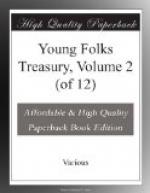A few days later Albrecht made his friends Hermann Gessler and Beringer of Landenberg governors over the free cantons, telling them to take soldiers with them to enforce the law and to tax the people in order to pay the soldiers. “You will punish all wrong-doers severely,” he said, “I will endure no rebels within my empire.”
Hard and bitter days began when Gessler and Landenberg settled there. They delighted in oppressing the people. They loaded them with taxes; nothing could be either bought or sold but the governors claimed a great part of the money; the slightest fault was punished with long imprisonment and heavy fines. The people became sad and downcast, but still they would not yield to Austria.
Gessler lived in a great castle at Kuessnacht in Schwyz. In it were dreadful dungeons where he imprisoned the people and tortured them according to his wicked will. But he was not pleased to have only one castle, and he made up his mind to build another in Uri. So he began to build one near the little town of Altorf, which lay at the other end of the Lake of the Forest Cantons. Gessler forced the men of Uri to build this castle, and he meant to use it not only as a house for himself, but as a prison for the people.
“What will you call your castle?” asked a friend one day, as they stood to watch the building. “I will call it the Curb of Uri,” said Gessler, with a cruel laugh, “for with it I will curb the proud spirit of these peasants.” After watching the work for some time, Gessler and his friend rode away. “My friend,” said Gessler, as he rode, “we will go back to Kiissnacht by another way. I have heard that an insolent peasant called Werner Stauffacher has built himself a new house. I wish to see it. There is no end to the impudence of these peasants.” “But what will you do?” asked his friend. “Do” said Gessler, “why, turn him out, to be sure. What need have these peasants for great houses?” So they rode on to Stauffacher’s house. “Whose house is this?” he demanded. Stauffacher answered quietly, “My lord, this house belongs to the Emperor, and is yours and mine in fief to hold and use for his service.” “I rule this land,” said Gessler, “in the name of the Emperor, and I will not allow peasants to build houses without asking leave. I will have you understand that.” And he rode from the doorway. Stauffacher told his wife what had happened and she advised him to call a secret meeting of his friends to plan to free themselves from the governor’s rule.
Werner Stauffacher spent some days in going from village to village, trying to find out how the peasants and common people felt, and everywhere heard complaints and groans. Coming to Altorf, where his friend Walter Fuerst lived, he heard in the market-place a great noise of shouting and trampling of feet.
Down the street a party of Austrian soldiers came marching. One of them carried a long pole, and another a red cap with a peacock’s feather in it. Then the pole with the red cap on the top of it was firmly planted in the ground.




